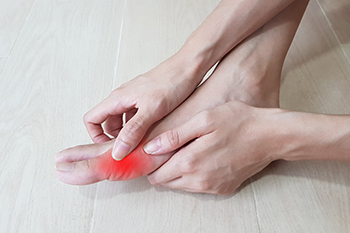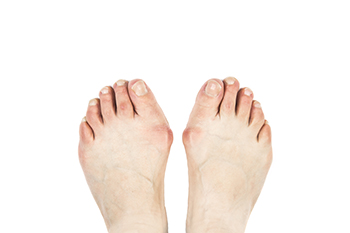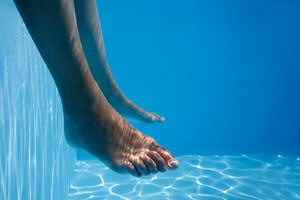Items filtered by date: January 2023
A Common Running Injury

The Achilles tendon is located in the back of the lower leg. It is responsible for pointing and flexing the foot, which is needed for walking, running, and jumping. An Achilles tendon injury can cause severe pain, and it can be difficult, if not impossible to walk. This type of injury can happen from increasing speed and distance too quickly while running, in addition to not properly warming up and cooling down. Research has shown that injuring this tendon accounts for approximately 10 percent of all running injuries, and men are more commonly affected. Patients who have weak calf muscles and a limited range of ankle motion may be prone to incurring a running injury, which may injure the Achilles tendon. Some have found relief when the affected foot is rolled on a tennis ball or bottle of water. This can be helpful in gently strengthening the Achilles tendon, in addition to elevating it as often as possible. If you have injured this tendon, it is strongly advised that you seek the counsel of a chiropodist who can offer you the correct treatment program.
Achilles tendonitis is a common injury of the Achilles tendon, a band of fibrous tissue that runs along the back of the lower leg. The Achilles tendon can also rupture, making it impossible to lift the foot. If you are suffering from heel or calf pain, please consult with Chiropodist Stephanie Poupore from North Bay Foot & Ankle. Our clinician can help you maintain the health of your lower limbs and your mobility.
Causes of Achilles tendon injuries include:
-
Repetitive stress or overuse
-
Sudden increase in activity levels
-
High impact injury
-
Calf muscle tightness or weakness
-
Altered foot biomechanics
-
Heel bone spurs
-
Underlying medical conditions that weaken the tendon
Symptoms of an Achilles tendon injury include:
-
Heel and calf pain that worsens following exercise
-
Chronic heel and calf pain
-
Sudden pain in the back of the ankle or calf
-
A popping or snapping sensation
-
Thickened lump in the Achilles tendon
-
Ankle and calf stiffness
-
Decreased range of motion in the affected foot
-
Swelling
-
Difficulty walking
Treatment
-
Resting the affected leg
-
Applying ice
-
Compressing the foot and ankle
-
Elevating the injured leg
-
Wearing orthotics
-
Low impact exercises
-
Stretches
-
Strengthening exercises
-
Non-steroidal anti-inflammatory medications
-
Cortisone injections
-
Surgery, if the tendon is ruptured
Achilles tendon injuries can be very painful and lead to reduced mobility if left untreated. If you have any questions, please feel free to contact our office located in . We offer the newest diagnostic and treatment technologies for all your foot care needs.
Reasons Why Bunions May Develop

A noticeable bulge on the side or base of the big toe can be characteristic of a bunion. It is considered one of the more common foot problems and may happen to people who wear tight shoes or high heels. It may also occur from genetic reasons, and severe bunions may cause the other toes to shift toward each other. Additionally, existing medical conditions may lead to getting a bunion, including arthritis, abnormal foot structure, or neuromuscular diseases such as cerebral palsy. Common symptoms of a bunion can consist of achiness, redness, and the affected area may be swollen. Patients have found mild relief from bunions by wearing supportive shoes with adequate room for the toes to move freely in, or by taking anti-inflammatory medicine. Surgery may be required for permanent removal of severe bunions and reshaping of the toe. If you have a bunion, it is advised that you consult with a chiropodist who can determine what the best course of treatment is for you.
Bunions progressively worsen over time and may cause walking in your shoes to become difficult. To learn more about bunions, please consult with Chiropodist Stephanie Poupore from North Bay Foot & Ankle. Our clinician will assess your condition and provide you with quality foot and ankle treatment.
What Are Bunions?
A bunion is a bony bump that protrudes from the base of the big toe. Bunions are caused due to a misalignment of the first metatarsal. The characteristic bump of a bunion forms when the metatarsal shifts outwards from its proper position. Bunions develop slowly over time and progressively worsen without treatment. The skin over the bunion may develop calluses due to the friction from shoes. Eventually, a bunion can make walking uncomfortable or even painful. Bunions are one of the most common foot deformities and are especially common in women and older adults.
Symptoms
A bunion appears as a bulging bump on the outside of the base of the big toe.
The bunion may also:
-
Be swollen, red, or sore
-
Develop corns or calluses over it
-
Cause pain
-
Limit the big toe’s range of motion
Treatment
There are several different treatments available for bunions. Conservative treatment options include wearing shoes with a wider toe box, cushioning the bunion with a specialized pad, wearing shoe inserts, icing the bunion if it becomes inflamed, and taking medications to relieve pain. In more severe cases, more invasive procedures may be done. This may involve removing the swollen tissue around the bunion, straightening the big toe, realigning the bones at the front of the foot, or a combination of these procedures.
If you have any questions, please feel free to contact our office located in . We offer the newest diagnostic and treatment technologies for all your foot care needs
Foods That May Cause Gout

Gout is a form of arthritis that frequently occurs in the big toe. It is caused by having a high level of uric acid that breaks down purines, which naturally occur in the body. Eventually, the purine forms crystals that gather in the joints of the big toe causing swelling, redness, and sudden extreme pain. Many foods contain purines and eating them can increase the likelihood of an outbreak of gout. The top four foods that have an abundance of purines are red meats, seafood, alcohol, and beer. In addition, beverages with a high amount of sugar are thought to contribute to gout attacks because they raise the level of uric acid. Certain vegetables, including spinach, cauliflower, asparagus, and mushrooms, contain high amounts of purine. Experts recommend reducing your intake of such vegetables if you are at risk of gout. On the other hand, some foods can help reduce uric acid levels. Among them are soy and low-fat dairy products, and vitamin C supplements. For more information on the prevention and treatment of gout, please consult a chiropodist.
Gout is a painful form of arthritis that can affect anyone. Please consult with Chiropodist Stephanie Poupore from North Bay Foot & Ankle. Our clinician will assess your condition and provide you with quality foot and ankle treatment.
What Is Gout?
Gout is characterized by sudden, severe attacks of pain, redness, and tenderness in the joints. This type of arthritis is caused by a buildup of uric acid in the bloodstream. When uric acid crystallizes in a joint, often the joint of the big toe, it can bring about a gout attack.
Symptoms
Symptoms of gout include:
-
Sudden and severe pain
-
Swelling
-
Redness
-
Warmth
-
Joint stiffness
-
Joint deformity
Diagnosis
A chiropodist will ask questions about your personal and family medical history, followed by an examination of the affected joint. Laboratory tests and x-rays are sometimes ordered to determine if the inflammation is caused by something other than gout. A sample of fluid taken from your joint can show whether it contains uric acid.
Treatment
Prescription medications or injections are used to treat the pain, swelling, and inflammation. Patients with chronic gout can also use behavioral modifications such as diet, exercise, and decreased intake of alcohol to help minimize the frequency of gout attacks. Foods and beverages that are high in purines should be avoided since purines are converted in the body to uric acid. If left untreated, this painful condition can leave your joint permanently damaged and swollen.
If you have any questions, please feel free to contact our office located in . We offer the newest diagnostic and treatment technologies for all your foot care needs.
Get Professional Care for a Broken Foot or Ankle
Finding Footwear for Wide Feet

Having wide feet can pose problems when it comes to finding shoes that fit properly. While having wide feet is not normally considered to be a medical problem, sometimes they can be caused by other health difficulties. Swelling, getting older, and foot deformities are some reasons that your feet may widen. What’s more, wearing shoes that are too narrow can be linked to bunions, blisters, corns, and other deformities of the toes. A checklist of ways to ensure that your shoes fit properly starts with measuring the feet. When trying on shoes, make sure the toes are not cramped. Experts recommend having about half an inch between the toes and the tip of the shoe. Footwear that is more squared in the toe box is thought to be a wise choice. Ask if the shoes come in a wider size, or find a store that specializes in wide feet. Most importantly, make sure your new shoes are comfortable. Wear the socks you would be wearing when you try on shoes, and shop later in the day when the feet are apt to be the widest. For further guidance on dealing with wide feet, please consult a chiropodist.
Finding the right shoes can be a hassle, however, wearing properly fitted shoes is one of the best things that you can do to prevent future foot problems. For more information about the importance of wearing the right shoe size, please consult with Chiropodist Stephanie Poupore from North Bay Foot & Ankle. Our clinician can help you maintain the health of your lower limbs and your mobility.
Tips for finding shoes that fit
-
Measure your foot - This should be done later in the day when your feet are naturally at their largest. An associate at a shoe store can measure your foot using a Brannock device.
-
Wear the right socks - You should be wearing the socks or other hosiery that you intend to wear with the kind of shoe you are looking for. For example, if you are shopping for running shoes, wear the socks that you would normally wear while running.
-
Remember these numbers - When trying on shoes, there should be about ½ an inch of space between the end of your longest toe and the end of the front of the shoe, and ⅛ of an inch between the back of your heel and the shoe
-
Don’t “break them in” - Any shoes you buy should be immediately comfortable; don’t settle for shoes that you have to “break in" before you can wear them out.
A chiropodist can help you find the best shoes and orthotics to help maintain the health of your feet. If you have any questions, please feel free to contact our office located in . We offer the newest diagnostic and treatment technologies for all your foot care needs.
Avoiding Foot Injuries While Rafting

Non-serious injuries from river rafting, such as stubbed toes, sunburn, and blisters are preventable but can cause discomfort. Wearing good quality water shoes is a primary step in taking care of your feet when participating in water rafting. Make sure shoes are well-fitting and comfortable, remember to use sunscreen on your feet, and be aware and watch your steps. It is easy to roll your ankle, bang a toe, or fall when getting on or off a raft. If you have sustained a foot or ankle injury while river rafting, or if you would like to learn more about prevention techniques before such a trip, consult with a chiropodist, an expert in the health of feet and ankles.
Injuries to the foot and ankle are very common among athletes. If you have experienced an injury, please consult with Chiropodist Stephanie Poupore from North Bay Foot & Ankle. Our clinician will assess your condition and provide you with quality foot and ankle treatment.
Common Injuries Among Athletes:
-
Achilles tendon injuries
-
Ankle strains or sprains
-
Plantar fasciitis
-
Fractures
-
Turf toe
-
Joint dislocations
-
Sever’s disease
-
Morton’s neuroma
Symptoms
Symptoms will depend on the cause and severity of the injury. Common symptoms for a foot or ankle injury include pain, swelling, tenderness, bruising, a reduced range of motion, and difficulty bearing weight or walking on the affected foot or ankle.
Diagnosis
Sports injuries are typically diagnosed after carefully examining the affected foot or ankle. This includes moving the injured area to test its range of motion. Medical history will need to be provided, as well as detailed information about how the injury occurred. Imaging studies, such as X-rays or MRIs, may be used to confirm or rule out certain diagnoses.
Treatment
Just like symptoms, treatment will depend on the type of injury and its severity. Initial treatment for many sports injuries is aimed at controlling inflammation and promoting the healing response. The acronym R.I.C.E is a helpful guide to implement for most acute injuries. This method involves resting, icing, compressing, and elevating the affected foot or ankle. In addition, anti-inflammatory medications may be administered and orthotic devices may be prescribed. For more severe injuries, surgery may be required. Lastly, rehabilitation or physical therapy may be needed to gain full functionality in the afflicted area.
If you have any questions, please feel free to contact our office located in . We offer the newest diagnostic and treatment technologies for all your foot care needs.

